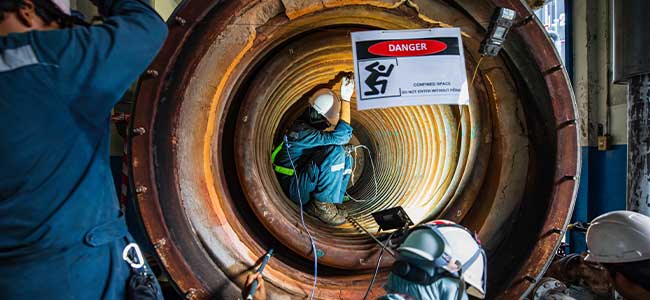
Confined Space Fall Protection: Hazards, Highlights and How to Keep Workers Safe
Confined spaces present unique fall hazards, but these risks can be mitigated through proper assessment, effective fall protection solutions, and thorough training.
- By Philip Jacklin
- Sep 10, 2024
The risk of slipping, tripping or falling is prevalent in many facilities and job sites. In fact, falls are the second leading cause of occupational deaths, only surpassed by automobile accidents. Confined spaces carry similar risks and hazards but add to the complications with physically or atmospherically challenging environments for workers to perform their duties. A 2020 fact sheet published by the U.S. Bureau of Labor Statistics (BLS) reported that 1,030 occupational deaths were linked to work in confined spaces. Of those deaths, falls to a lower level accounted for 156 fatalities, second only to trench collapses.
To reduce the number of fall injuries & fatalities, it’s first necessary to start reducing the number of falls occurring. Confined spaces pose unique risks to workers, but fortunately, they can be mitigated just like any other workplace hazard. The Occupational Health & Safety Administration (OSHA) believes all falls are preventable, even falls in confined spaces. Let’s discuss some unique challenges in developing a confined space fall protection program, how to address fall hazards systematically and how to maintain a comprehensive program that keeps confined workers safe.
Definitions of Confined Spaces
As far as OSHA compliance is concerned, a confined space is defined as a working environment with limited or restricted means of entry and exit, specifically an access point less than 24 inches in diameter. Examples of confined space work environments include underground vaults, tanks, storage bins, hoppers, ingot pits and diked areas, vessels, silos and other similar areas. Personnel working in confined spaces are often subjected to increased risk of entrapment, engulfment and hazardous atmospheric conditions.
Additionally, a permit for entry must be obtained if a confined space contains any of the following conditions:
• A hazardous atmosphere (or one with the potential to become hazardous).
• Material that has the potential for engulfing an entrant.
• An internal configuration that could cause an entrant to be trapped or asphyxiated by inwardly converging walls or by a floor, which slopes downward and tapers to a smaller cross-section.
• Any other recognized serious safety or health hazard.
Permit-required confined spaces contain an increased risk of falls due to the hostile atmospheric conditions present. Respiratory protection gear should be properly fit-tested per manufacturer instructions while wearing fall protection equipment to ensure compatibility & worker safety.
This article originally appeared in the September 2024 issue of Occupational Health & Safety.